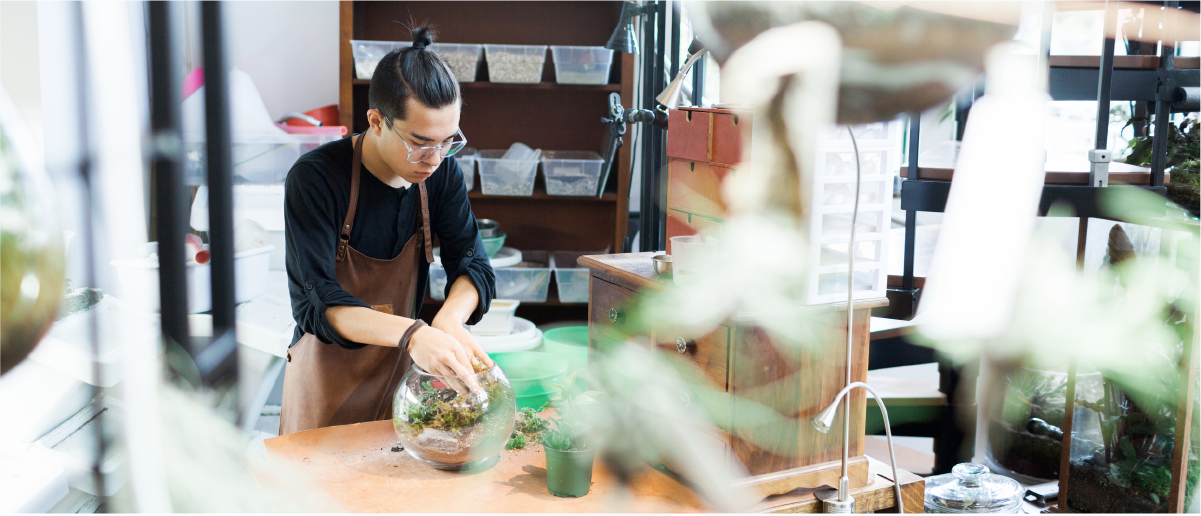
February 21, 2016
Though they are most famous for their beautifully contrasting textures, bold shapes and exotic colors, tropical houseplants also fulfill a much needed function in modern homes—they produce fresh oxygen indoors and actually scrub the indoor air of any toxic dust and chemicals. And they do all this 24 hours a day, 7 days a week.
According to the US Environmental Protection Agency (EPA), most people spend 90% of their time indoors. Studies from the EPA have found levels of indoor air pollution can be from two to five times higher, and in some cases even 10 times more polluted than the outdoor air.
What kinds of toxins? Volatile organic compounds (VOCs) are released by ordinary household products such as paints, carpets and ink. Not to mention the stuffiness caused by all the carbon dioxide produced by our own normal breathing in a closed space.
But houseplants absorb up to 87% of these pollutants and, unlike our housemates and family members, plants actually love our morning breath. And in exchange they give to us pure, cool, fresh oxygen. Houseplants and human beings really are a match made in heaven. Maybe that's why we started out in a garden.

Many houseplants thrive with very little care compared with the benefits they provide. Some of the best houseplants for absorbing airborne toxins are also the easiest to grow. They include cast Iron plants (aspidistra), spider plants, peace lilies, calatheas, Chinese evergreen (pictured above), dracaenas, philodendrons, columnea and pothos.
Come visit us here at Roosevelt’s Terrariums to learn more, and we will help you pick out some real “air purifiers” for your home and workplace. What's more, we will help you be successful in keeping them happy and healthy.
February 15, 2016
Being sealed is essential. A terrarium by definition is a closed, self-contained, recycling ecosystem. What makes a terrarium work is the fact that it is closed off from the harsher environment surrounding it. That is why you can grow things in a terrarium that you cannot grow out in the open. A terrarium supports the tropical and woodland plants inside by protecting them from cold drafts, dry heat and poor air quality.
A terrarium is a self-perpetuating, tropical ecosystem. In other words, a TRUE TERRARIUM WITH A LID. Here in the shop, we have a saying:
“If it doesn’t have a lid, who you trying to kid?
It’s not a terrarium.”

May 02, 2015
What is a lichen? Well, according to Irwin Brodo, Sylvia and Stephen Sharnoff in their book, Lichens of North America, “lichens are a composite of a fungus and an organism capable of producing food by photosynthesis.” But that’s complicated. What you need to know is that lichens are diverse, colorful, and absolutely beautiful!
Lichens are everywhere in the Northwest, and you can collect your own to grow in your home terrarium! (Be sure to follow the federal and state rules and regulations, no one wants a fine for collecting plants illegally.) Lichens are slow growing, and relatively fragile, so be careful while collecting, transporting, and transplanting.
Here is how you can collect coveted lichen and bring it home with you!
1. Use a spray bottle to mist the lichen or poor a little bit of water directly onto it. It is much easier to collect lichen when it is wet without damaging it.
2. Break off a small piece of the lichen. They are incredibly slow growing, so get enough for your terrarium, but be sure to leave some so that it can reproduce in its natural environment.
3. Put your lichen into a paper bag to transport it. Be sure to fold the top of the bag over to keep it from drying out. If

you have a long journey, be sure to mist it regularly to keep it moist and healthy.
4. Place the lichen on a moist rock, small piece of wood, or directly on the surface of your terrarium. Over time (a lot of time) it will grow and spread.
5. Once your terrarium is complete spray the lichen regularly to keep it moist. It needs moisture to continue growing and repopulating. Just keep doing that, and you’re set; your pleasant experience with lichen has just begun.
February 13, 2015
What’s an Air Plant?
These beautiful, spiky, and interesting plants seem to have captured the hearts of professional and amateur decorators, architects, and hobbyists. But what exactly are they, and how should we best care for them?
Epiphytes, or air plants, grow naturally in tropical climates. They live by attaching themselves to trees, moss, or other surfaces and by collecting nutrients from water they collect from the air.
Light
Air plants need bright, indirect sunlight. Direct sunlight might be okay for small amounts of time. However, if air plants are left in direct sunlight for more than a few hours they will begin to dry out.
Water
We recommend watering your air plants by giving them a thorough rinsing under running water or by letting them soak in a bath of water for 20–30 minutes once a week. Your air plant should be watered at least once a week. You should notice that air plants will be softer and lighter in color when they are in need of watering.
Temperature
Air plants grow best in generally warm conditions between 50–90 degrees.
Do you have any questions about air plant or terrarium care? Contact us.
